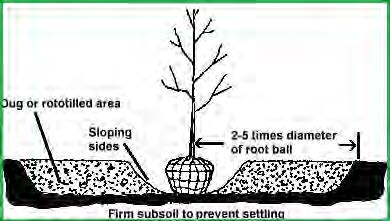AgEBB-MU CAFNR Extension
Green Horizons
Volume 23, Number 3
Fall 2019
Urban Forestry
Fall is the Perfect Time to Plant a Yard Tree
By Hank Stelzer | MU School of Natural Resources Extension
The fall season is an excellent time to plant new trees in your yard. Fall planting allows for root development to occur prior to winter's arrival. These fall roots help the tree become established before the hot, dry conditions of next year's summer arrive. The ideal time to plant in the fall is between mid- September and the end of October. Planting later into November decreases the amount of root growth before the soil cools. A good rule of thumb is that if the trees in your area still have leaves, you can plant new trees. Better yet, look to the soil! Using a soil thermometer, measure soil temperature early in the morning for a few, consecutive days. If your soil is consistently 50℉ or higher, you are good to plant. Planting in fall varies little from spring procedures. Most important is to select the right plant for the right location. This will require research before heading to the nursery to pick out the plant. Know the height, spread and shape of the tree that is needed in the landscape. Always plan for the mature size of the plant. This prevents plants from overtaking the allotted space and reduces maintenance such as pruning. Avoid fall planting of trees in locations that are prone to excessive cold winter winds or cannot be watered. The planting hole for your tree is important. It is often said, dig a hundred dollar hole for a twenty-five dollar plant. This is truer now than ever backed by current research. It is better to dig the hole wider than deeper. Digging deeper than the root ball depth causes the plant to settle. This settling results in an unhappy root system that is often prone to decline in our heavy clay soils. The width of the planting hole should be two to five times the diameter of the root ball (diagram, right). This loose soil around the root ball allows for quick root growth into the soil from the root ball. When backfilling, do not stomp the soil, as this causes compaction and slows root growth. Either lightly firm the soil or allow water to naturally settle the soil.
 |
Once the tree is planted, keep it properly watered. Dry soil conditions during winter are one of the main drawbacks to fall planting. We often forget to water during the cold of winter. The soil will absorb water unless frozen. When watering, deeply soak the soil and allow it to dry before reapplying. Check the moisture level and water as needed throughout the entire winter. Normally, young trees are not fertilized at the time of planting. Wait one growing season before applying the nutrients. The only exception would be a root starter type fertilizer. Establishing roots is more important in the early stages of growth than top growth. A word (or two) needs to be said about planting smaller, bare-root forest tree seedlings. These plants start their life out as a seed in the spring and need to be conditioned before being planted in the forest or an old field. This conditioning requires these seedlings to remain in their nursery beds through the fall and early winter months before they are ready to face the world. We will talk more about planting forest tree seedlings in the winter issue of Green Horizons. An excellent reference is MU Guide G6850, How to Plant a Tree. Take advantage of the fall season and add new trees to the landscape, it is a great time. But remember, care is just as important for success as in the spring.
For more information about tree planting, visit the University of Missouri's Extension guide at https://extension2.missouri.edu/g6850
